

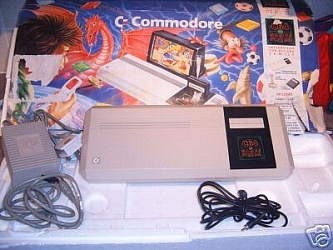
The C64GS - Games System
Picture from the auction - Better to come
What a mistake to make ... That's how I view this particular Commodore incarnation. Released in 1990 some eight years after its base technology was created to the C64, evidently to compete with the growing console market. Sadly, loads of Commodore based games utilised some form of keyboard control and this machine did not have that facility. Although numerous games were promised for this machine only a small number found their way onto the platform. This machine was only released in Europe.. By 1990 I guess the writing was on the wall regarding Commodore and there failed commercial ventures. Although I already own a C64GS I don`t have a box. And therefore I fought hard for this machine, just so I can view first hand the art work to the box. The machine came without cartridge, joystick and manual. Fortunately I already possess these and so I now have a complete set up. Strange beast this one... Not sure.
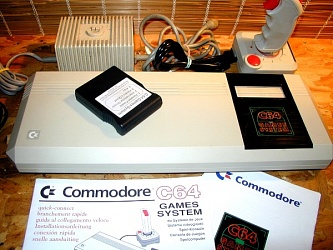
Picture of my other C64GS
There are odd items that I seem to consistently fail in obtaining. The FMV unit for the CD32 comes to mind. Imagine my pleasure at not only winning a 1764 but also finding out the seller was very local. I was also pleased cus the guy sold me a Commodore 1942 monitor, which I discuss below. This expansion was a great move forward for Commodore at the time giving programmers far more to get their teeth into. You just have to remember to up the power on the C64. At the Winter 1987 CES, Commodore introduced the 1764 RAM Expansion Module for the Commodore 64. The price then was US$129. It provided 256 KB RAM for use as a RAM disk. Although the C=1764 was originally advertised for the C64, and the 1700 and 1750 for the C128, any of the three RAM expanders will work with either the C64 or the C128. Note that if you want to use any of them on the C64, you need a heavy duty power supply. The 1764 comes with such a power supply. What is an REU? An REU is a Ram Expansion Unit that plugs into the cartridge port of the Commodore 64 or 128. Commodore made three different types of REU's. The 1700, 1764, and 1750. For some unknown reason, Commodore stopped making these units prematurely. Other companies manufactured similar devices, and call them clones. The REU most users prefer is the 1750, as it came with 512K extra RAM, and this can now be upgraded to have up to 2 megabytes of RAM. Under normal use, the REU is used as an extremely fast disk drive. Programs are copied to the REU, and run. These devices are practical for using with slow programs such as GEOS, and with some word processors, to make dictionary sub-programs operate with lightning speed. One of the limitations of an REU is that what is stored in it will disappear when the computer is turned off. To use a 1750 REU with a C64, your C64 needs a heavy duty power supply, because the RAM Expansion Unit is powered by the computer. http://cbm.videocam.net.au/c64info.php
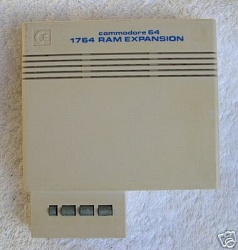
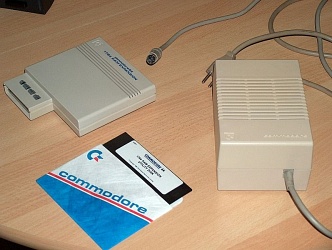
Picture courtesy of the seller and Wikipedia
In addition to obtaining the 1764 I was also offered the following card from the seller, which I grabbed literally. I hadn't seen the card before, so again I was well pleased to have met up to collect the 1764. I have also been offered another A2000 which sounds in wonderful condition, so I will be putting all these bits and pieces into the one machine. Yet another project starts. Great fun. [ blurb from the Big Book ] The ImpactVision 24 is a full length Zorro II framegrabber with limited "graphics card" support. Although this card is listed as an RTG graphics card, the only support it has in this respect is with the ancient EGS system, so it is not clear how well the IV24 performs as an RTG card. There are two versions of the ImpactVision 24, one which is designed for use with the older ECS/OCS video slots, whilst the newer version (eg Rev 8) which is designed for use with the AGA video slot as found in the A4000 series machines. The card contains 1.5MB of RAM and is capable of capturing at 768x580 in 24bit and supports PiP (Picture in Picture). The card includes a standard 15pin (possibly 9pin?) VGA/SVGA connector which can output video at both 31Khz and 15Khz. The card was usually supplied with IVPiP, IVCP, IVGrab, IVView, IVRead, IVCMD, Scala, Calligari and Macropaint. There are at least 5 revisions of this card. Revision 5 cards using 3.10 ImpactVision ROMs have been reported not to function correctly in an A4000 with Kickstart 3.0. several other units were designed for use with this card such as the RGB Splitter and Component Transcoder.
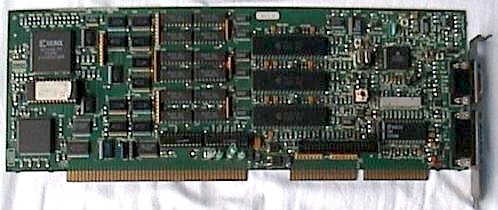
Picture courtesy of the Big Book of Hardware
Back in 1995 I recall most PC folk being very excited by the Intel processors and the new CDs appearing on the machines. For me I was trying to afford the new ZIP drive for the A1200. The 100MB capacity, after struggling with DD and HD was just a dream. I kinda remember these SyQuest drives with the 135MB capacity though I can`t recall the cost at the time. Took me some considerable time to get the ZIP, which I still have on two Amigas. Great, cus I can use them also on the PC. This drive is the third strange drive that I have obtained this session. Wasn't intentional, but now I can add the Syquest to the LS120 and the Floptical Drive that I received earlier this month. All are compatible with the Amiga and will find their way into my tower project. Specifications Capacity: 135MB Average Seek Time: 13.5ms Burst Transfer Rate: 4MB/sec Buffer Size: 64K Mechanism rated for: 200,000 hours Unfortunately, the EZ 135 Drive was not backwards compatible with other SyQuest drives, and the original capacity was never increased beyond 135MB. The Zip drive became very popular, and SyQuest's sales declined. Interfaces The EZ 135 Drive was available with several interfaces. The external drive was available with parallel or SCSI interfaces. The internal drive was available with IDE or SCSI interfaces.
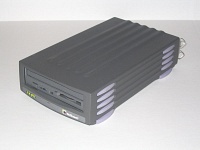
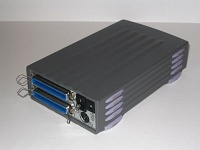
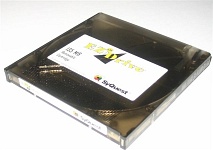
Picture courtesy of Wikipedia
The Macintosh emulator for the Amiga On my MAC theme last blog I had arrive this week a very interesting box. Inside is the A-Max-II emulator for the Amiga... This is a hardware and software combination that allows your Amiga to run most Macintosh productivity software. You get this very strange A-Max-II cartridge with legs. To make it work you need Apple 128K boot ROMs these come as a set of two 28 pin chips from an original MAC 512kE or a Mac Plus. I have what looks like a 30 pin SIMM which I have no idea where this goes.. The ROMs fit inside the cartridge, which has legs to stand up at the back of the 2000. The small legs are for the A2000, the large legs are for the Amiga 1000. The box came with loads of disks including ' An Introduction to Apple Macintosh System 7 ' If I pick up the 2000 this week I will try the cartridge out then. The emulator boasts... Access to partitions on hard drives during Macintosh emulation (supports most hard drive controllers) Access to Macintosh SCSI peripherals such as the LaserWriter IICS, hard drives and scanners through your Amiga hard drive controller's SCSI port. Improved handeling of Amiga accelerator boards, for maximum speed and compatibility - software runs up to five time faster. Plays Macintosh digitized sounds. Compatible with all Amiga models. Supports the use of the Amiga mouse, keyboard, 3.5" drives, serial and parallel ports during Mac emulation. Reads Magic Sac and Spectre disk formats (Atari ST, Macintosh Emulators) Supported video modes include: 640x400 (interlaced), 640x200 (with scrolling), 512x342 (Mac standards size, interlaced) and 1008x800 with the A2024 or Moniterm Viking monitor. Support for PAL screen sizes up to 640x512 (interlaced). Compatible with Flicker Fixer. Uses all available Amiga RAM during Mac emulation (some Mac programs may not be compatible with memory beyond the first 512k) Built-in Apple Imagewriter emulation for 9 and 24 pin Epson compatible printers. Transfer software to convert files from AmigaDOS to and from A-Max II and Mac disk format) Built-in recoverable bootable RAM disk. Runs HyperCard, Multifinder, MacWrite, MacDraw (1 & 2), PageMaker (1.2), MacTermial, all system disk versions compatible with 128 ROMs and most other productivity software. A-Max II may not run all games and Midi software.
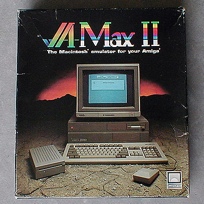
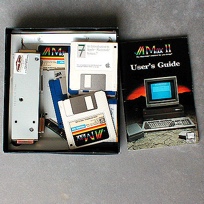
Picture courtesy of the seller
Along with a number of other interesting goodies this week, acquired during my collecting, I obtained another Spectrum+2. The computer is in good working order and puzzled me somewhat with the greeting message when switched on.. 1982 Amstrad... Strange, cus the Spectrum wasn`t in the hands of Sugar 1982, if I have my History correct. With these machines you get an option screen on reset.. Loader +3 BASIC Calculator 48 BASIC 1982-1986-1987 Amstrad Plc Drive M: Available. Interestingly there were several models of the Spectrum+2. There was the grey case versions which were pretty well the same motherboard as the 128. Then there were the +2A and +2B black case models which were simply the +3 models but with tape recorders instead of the 3" drive. The model reference was given due to a change in the manufacture location from Hong Kong to Taiwan. Sadly the earlier ROMs developed for the Amstrad did have compatibility problems with the earlier Spectrum games. Although Sir Clive Sinclair was a great inventor he was pretty rubbish at the old marketing of his product. So, he sold the Spectrum along with the Sinclair name to Alan Sugar and Amstrad. Although the +2 boasted a better keyboard and some extra ports it did lack the old tape counter ( duh ) which any computer whizz of Sinclair days would have needed as an essential. The joystick port was also only comptible with the Amstrad joysticks. Saying all that the Spectrum +2 was a pretty powerful computer for its day and did provide the all important tape deck... even if it didn`t have a volume control and counter.

Picture courtesy of Computer Museum
[ Collectors retrospective March 29th 2007 ] Hi Went to pick up the 1764 RAM expansion for the C64 tonight and finished up fulfilling a wish I had back in 1993.... Back then when I bought my first A1200 I also paid an advance payement of £50 for a Commodore 1942 monitor. Sadly Commodore went bust and I never did get my monitor... Well that was till tonight when for £50, which was the down payment on the monitor back then, I finally got to buy a 1942 monitor. Felt really really strange plugging her into the 1200, and kinda bought a tear to my eye. This wonderful 1200 has been my bestest of friends since 1993 and still provides such a magic amount of joy. And tonight she was united with the Commodore monitor she had been promised that cold November back in 1993.. Better late than never I would say. And if you have never owned and Amiga you really will never understand the love affair with the computer... More than a computer... More than a computer... Happy scuzz
If you can only see this CONTENT window
then click the image above for the full site
Last updated 31st March 2007
Chandraise Kingdom